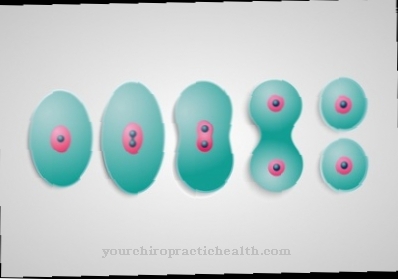Under the Cardiac output In medicine, the volume of blood that is pumped from the heart through the entire bloodstream in one minute is understood. It thus represents the unit of measurement for the heart's pumping function and is also called Cardiac output designated. The cardiac output is obtained by multiplying the heart rate by the heart rate.
What is the cardiac output?

All multicellular organisms need an efficient system that supplies the cells with everything they need. Energy can be stored in the cells, oxygen or carbon dioxide must be delivered or transported away. This cycle is ensured by the performance of the heart.
Switched cells that require more or less power and energy also have to be supplied in the same way. The heart is therefore regulated over a wide range of performance. This takes place via a current or pulse that can be measured. The stroke volume times the heart rate gives the cardiac output, abbreviated HMV.
Function & task
The control of the cardiovascular system arises from the blood pressure. As soon as the person moves faster, the need for oxygen in the muscles increases, blood pressure drops and has to be increased again. As a result, the cardiovascular system in the "medulla oblongata" increases the so-called sympathetic tone. The elongated medulla of the "medulla oblongata" is the caudal part of the brain that serves as the transition from the spinal cord to the brain stem. The sympathetic tone acts as an alarm reaction in the body, which is characterized by a surge in blood and an increased heart rate. The reaction leads to a constriction of the vessels via alpha receptors in organs that are not needed at the moment, such as the skin or certain tracts of the kidneys. The return flow in the veins is also increased, while the pumping capacity of the heart via beta receptors is increased.
Sinus nodes, Purkinje fibers, bundles of His and one right and two left Tawara limbs form the stimulus conduction of the heart and tend to spontaneously depolarize. The sinus node is particularly active in the resting frequency of around sixty pulses per minute. By activating the sympathetic nervous system, the sinus node is driven to rapidly successive depolarizations and has a “positive chronotropic” effect, i.e. an increased beat frequency, “positive inotropic”, increased contraction force, “positive dromotropic”, increased speed of stimulus transmission and “positive bathmotropic” , in increased excitation of the muscle cell membrane.
In short, the short-term control of the circulatory system takes place through regulation of the cross-sections of the vessels by the central nervous system.
The pressure volume can be measured during the heart rate. The stroke volume, in turn, is brought about by increasing the filling pressure of the blood to the heart and by increasing the contractility. The stroke volume is then multiplied by the stroke frequency, which is also higher under the influence of the sympathetic nervous system.
While the body is at rest, the cardiac output in a healthy and adult person is around five liters per minute. The heart index in its lower normal limit is 2.5 liters per minute. It is the parameter for the general assessment of cardiac output and is calculated as the quotient of cardiac output and body surface area. This metric plays an important role in hemodynamics and in collecting circulatory data for patients in the intensive care unit.
On the other hand, under higher stress the heart rate can be increased sixfold. Particularly during sporting activity or competitive sport, the cardiac output is sometimes over thirty liters per minute.
The measurement takes place in different ways. In clinical practice it can only be recorded indirectly. So z. B. by an echocardiography, from which the stroke volume and the heart rate can be roughly estimated. The diameter of the left ventricular outflow tract is measured as a 2D image. Another measuring method is the somewhat more complex thermodilution. A measured amount of cold liquid is injected into the patient and the temperature of the blood is recorded using a thermal probe.This can be done through the Swan-Ganz catheter, which is advanced through a vein in the neck through the right half of the heart until it reaches the pulmonary artery. The cardiac output is then determined with the help of a heating coil.
A cardiac catheter is also necessary for dye dilution procedures. Another method is to measure cardiac output using magnetic resonance imaging or impedance cardiography. The latter takes place as a non-invasive measurement.
Illnesses & ailments
If the pumping capacity of the right or left ventricle decreases, the result is a reduced cardiac output. This can e.g. B. triggered by hypothyroidism, but also by structural heart changes such as ischemia, tachycardia, bradycardia or cardiac valve damage.
The cardiac output also decreases with arterial hypertension or inhibited filling conditions of the ventricles. This occurs, for example, with thoracic deformities, with stiffening of the heart walls or with cardiac tamponade, whereby the entire heart action is disturbed by the accumulation of fluid and contraction movements are hindered. This in turn can be triggered by bleeding after a heart attack or pericarditis, an inflammation of the pericardium.
With an increased cardiac output, people usually suffer from anemia, fever or an overactive thyroid. The cardiac output also increases during pregnancy, since the body needs more blood to supply the uterus and placenta. The volume can also increase in the event of septic shock, even if there is a circulatory disorder in the organs.
Cardiac output also increases when certain drugs accelerate the heart's rhythm.













.jpg)

.jpg)
.jpg)











.jpg)